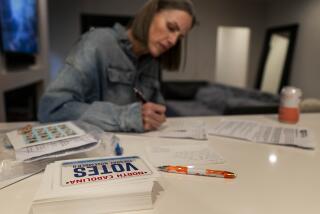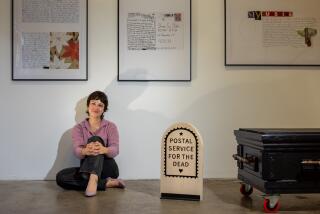Collecting Postcards From the Heart
- Share via
The Garcias never figured they would care that much about a pile of postcards.
“It started because we were always forgetting the camera,” explained Marie Garcia, the mother of three who lives in White Bear Lake, Minn. “We’d buy a postcard wherever we went and write a little bit on the back about our day.”
Soon the Garcia kids got an album for their cards. When they filled that, they got another. Now they like looking at their postcards so much they keep the albums in the car, adding to the books wherever they go.
Their collection is still very small--minuscule compared to that of a serious postcard collector such as Howard Woody, who teaches art at the University of South Carolina in Columbia.
“I’ve been at it for 40 years,” he said, resulting in a collection of 20,000 to 30,000 cards.
*
Woody and his friends started as teen-agers. They’d try to get one from every state, then every country, he said, sending them to each other wherever they went. The other kids quit eventually. But Woody said his collection has “followed me closet to closet ever since.”
“It’s affordable and you can tailor it to your own life,” Woody said, referring to collecting cards about favorite subjects or places.
Los Angeles pediatrician Jeff Fireman agrees. He has vacation cards dating back 30 years or more to when he was a child growing up in suburban Chicago. “It’s fun to look at them,” he said. “You take them out and get the feel of the place again.”
He is not alone in his affection for the pastime. Sending and collecting vacation postcards has become such an American tradition that the Smithsonian Institution’s year-old National Postal Museum in Washington is planning an exhibit for next year tentatively called “Are We There Yet?” (For museum information, call 202-633-9360.)
A current display at the National Postal Museum chronicles postcard history and our continuing love affair with them. The card craze started in Europe in the waning days of the 19th Century, said Nancy Pope, the museum’s postal history curator.
It soon crossed the Atlantic and by the first decade of the 20th Century, Pope said, families were competing to see who had the most postcards. In addition, they would hold postcard exchanges and even have family portraits printed on them.
*
In those early years when newspapers didn’t publish many photographs, postcards could also have significant news and historic value, especially after a disaster. “There were 100 postcard views of the Great San Francisco Earthquake,” Pope said. “That was how people would see what it looked like.”
As Americans began to travel more widely, postcards became the preferred way to show friends and family where they had been. “It became that cliched, ‘Wish You Were Here’ message,” Pope said.
Since then, many generations have discovered how much fun sending, receiving and collecting them can be.
“It’s an icon of the past and also the present. Postcard collecting is really popular now,” said Faith Ruffins, a historian at the Smithsonian’s National Museum of American History and an expert on the subject.
“We live so far from those who have meaning in our lives. Postcards are a way of giving evidence to people of what our lives have been about,” said Bernard Beck, a Northwestern University sociology professor and expert on popular culture.
*
Collecting anything and everything is popular now, Beck said, as if “everybody needs proof they’ve had a life.” Postcards offer tangible evidence that we’ve been somewhere and done something.
Even for kids. Too often, they get bored traveling because parents expect them to appreciate places from an adult perspective. Sending and collecting postcards might be a good way to sustain their interest in someplace new. “At least it might keep them out of mischief,” Beck said.
Ruffins, herself the mother of two young children, agrees that the century-old hobby is still a good bet for kids. “Postcards are visual,” she said. “They’re portable and they’re cheap.”
*
Ruffins recommends buying the kids multiple copies of the same card. They can send one to a friend, keep one and have one to use later for an art project or school report.
Marie Garcia was among several who wrote to me recently offering postcard-collecting strategies when I asked readers for ideas to help today’s families create some lasting memories.
“We always send a picture postcard back home with a short vacation memory written on it,” wrote Joan Kohn from Cleveland, Ohio. “Aaron is 3 1/2 and likes to get mail,” she explained. Besides, it’s such an easy thing to do.
Helpful too. After Shell Hoskinson’s grandmother and friends visited, he gave them each a postcard detailing highlights of their stay. That way, he explained, they could better recount their adventures when they got home.
“Anytime they couldn’t remember what they did, they pulled out the postcard from their purse and continued on with the story,” wrote Hoskinson of Wilsonville, Ore. “Each of my grandmother’s friends called to thank me.”
So maybe we should all stop shooting so much video on vacation and write a few more postcards. Jeff Fireman, for one, figures he’ll be enjoying his collection long after those vacation videos have been misplaced.
*
Taking the Kids appears weekly.
More to Read
Sign up for The Wild
We’ll help you find the best places to hike, bike and run, as well as the perfect silent spots for meditation and yoga.
You may occasionally receive promotional content from the Los Angeles Times.






